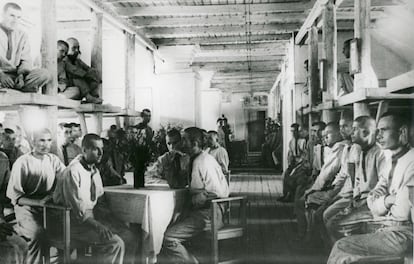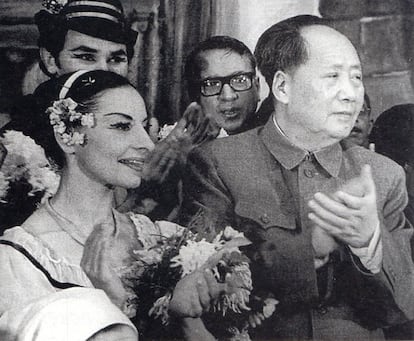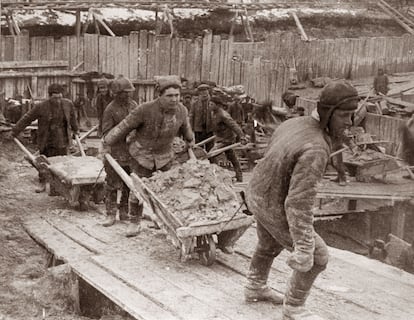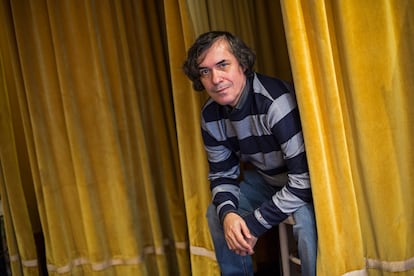Artists and writers sum up communism in three words: censorship, repression, death
The journalist and editor Manuel Florentín has published a chronicle of the persecution that totalitarian regimes have perpetrated against intellectuals and creators, from Lenin’s Soviet Union to Ortega’s Nicaragua

“What is called communism is nothing other than fascism with a red flag,” communist, lieutenant colonel in the Spanish Civil War, and anti-Stalinist Valentín González once said.
Communism’s dream of a just and egalitarian society became a nightmare from the first moment for those thinkers, novelists, poets, playwrights, journalists, artists, filmmakers, and musicians who did not agree with a totalitarian, single-party regime. The journalist, writer, and editor Manuel Florentín has published “a great chronicle” that covers this particular horror story, from Lenin’s rise to power in Russia in 1917 to Daniel Ortega’s Nicaragua. “I am a left-wing person,” Florentín says, “that is why I believe it is essential to criticize the crimes of communism from the left.”
The idea for this work, Escritores y artistas bajo el comunismo (in English, Writers and artists under communism), arose from one of his previous works in which he showed the other side of evil on the extreme right, Guía de la Europa Negra (Guide to Black Europe). “Through that, I realized how many books there were about Nazism and its crimes, but not about those of communism.” In 1997, the Russian newspaper Izvestia put the number of lives that communism had claimed since 1917 at 100 million worldwide.

The circles of descent into hell that affected artists and intellectuals ranged from censorship and banning publication or performances of their works to losing their jobs and their homes; exile, prison, torture, internment in concentration camps, and execution. Florentín delved into published books and reports, and used his journalistic experience, which allowed him to interview writers from behind the former Iron Curtain and cover the wars of the former Yugoslavia, among others.
The bulk of the book’s 912 pages focus on the Soviet Union. Florentín maintains that the persecution of intellectuals considered dissident or bourgeois was one of communism’s original sins. In December 1917, Lenin created the Commission for the Fight against Counter-Revolution and Sabotage, the sinister Cheka. “The list of books that should be censored and eliminated from Russia was drawn up by his own wife.” Books were burned and authors were banned. To lighten the very dark tone of the subject matter in this volume, the author intersperses jokes and examples of the black humor that emerged in communist countries, such as the one that said: “A prisoner asks for a book in prison. To which the guard responds: ‘We don’t have the book, but we have the writer.’”
Lenin littered Russia with concentration camps. “They were there since the time of the tsars, but under communist rule they went from 84 to 315 in just three years.” A fact that is overlooked by those who bristle when Lenin is called genocidal. One of the cruelest camps was Kolyma, during Stalin’s time. It is a name that, according to Florentín, should appear alongside Auschwitz.

Lenin had made clear “his postulation about what literature should be in 1905. Writers and artists had to put themselves at the service of the revolution,” Florentín says. If their work “exalted the workers and how happy they were, there were no problems, in fact, those protected by the regime lived very well.” This was the case for Maxim Gorky, who had participated in the October Revolution, although he later confronted Lenin, and had to leave the country. Stalin rehabilitated him. With his new status, he had to justify the farcical trials, publish writings against the convicted, and not lift a finger for defenestrated colleagues.
The playwright Vsevolod Meyerhold was an enthusiast of the revolution. However, in 1929 the staging of a social satire written by another author, who had been criticized by the official press, led to his downfall. His theater was closed, and in 1939 he was arrested. He was 65 years old, he was tortured for seven months, he cried in pain until his left arm was broken. His torturers left him healthy so he could sign his confession. His wife was found dead with her eyes gouged out — the crime was committed by the People’s Commissariat of Internal Affairs (NKVD) — and in February 1940, Meyerhold was executed.
Another enthusiast of the Revolution who was purged was Isaac Babel, the author of Red Cavalry and Odessa Tales, two books that the regime did not like. He was arrested, tortured, and executed in January 1940. His works were banned. His widow, when she asked about her husband’s fate, was told that he was in Siberia and he was fine. She did not know that he had been killed until 1954. Boris Pasternak had written poems in praise of Lenin and Stalin, but he ended up suffering because his most famous work, Doctor Zhivago, was branded “apolitical.” Pasternak was married, but had an affair with a woman 22 years younger. She was arrested, and in the torture she lost a son she was expecting. Pasternak was harassed by the state for the rest of his life.

Then there is the case of poet Osip Mandelstam and his wife Nadezhda, who was a writer. He was deported and died during his transfer to the gulag, an acronym for Main Directorate of Correctional Labor Camps and Colonies. He had been arrested for reciting epigrams against Stalin in which he said the leader had “a cockroach mustache.” His widow wandered around different cities because the order was not to give her work. A joke from the Stalinis period goes: “A man was sentenced to 15 years in prison for saying that Stalin is an idiot: one year for sedition and 14 for revealing a state secret.”
With Stalin’s successor, Nikita Khrushchev, “the thaw” and the first criticism of the Stalinist genocide began. But it was not a period without repression. “Psychiatric clinics were created. When someone was sent to those centers, they did not know when they would be able to leave. At least in the gulag they knew their sentence, although it was possible that when they were going to finish it, it would be increased.”
The writer Vasily Grossman, in his monumental Life and Fate, tells a joke about the Lubyanka, the KGB headquarters in Moscow, where detainees were taken. “It is the tallest building in the USSR. Why? Because you can see Siberia even from the basement.” Other victims appear in Florentín’s book, such as Aleksandr Solzhenitsyn, a communist, who in Gulag Archipelago (1973) recounted up to 31 methods of psychological torture during interrogations. Solzhenitsyn recounted firsthand his eight years of captivity.

The Cultural Revolution
Another notable chapter in this dark history is occupied by Mao Zedong’s China, and the so-called Cultural Revolution, of the early 1960s. “It was total repression. Mao was losing power because the Great Leap Forward [the industrialization program of the late 1950s] was a disaster. It is estimated that around 60 million people died during the period. That unleashed criticism in the party, and Mao, through the Red Guard, carried out a purge of the intellectuals and the party elite.”
That era would generate “the literature of scars,” written by former communists, including Red Guards, who had fled the People’s Republic. In the prologue, the historian Antonio Elorza remembers that in that delirium, “doctors, judges, teachers, and government officials were forced to tour the cities hungry and while suffering insults and attacks.”
One of the most heinous cases in China was that of the communist poet Lin Zhao, who criticized the excesses of the regime. She was sent to a forced labor camp in 1958. Her boyfriend suffered the same fate and was not released until 1979. She was released and imprisoned several times, until she went on a hunger strike and attempted suicide. In 1965, she was sentenced to 20 years in prison, but only three years later, she received the death penalty. She was executed at the age of 36, in April 1968. On her last day of life, she was even prevented from saying a few last words by placing a rubber gag in her mouth.
This map of horrors has stops in countries like Poland, where the essayist and journalist Adam Michnik was imprisoned several times; or the 1980 Nobel Prize winner in Literature, Czeslaw Milosz, who had to go into exile. The writer Guillermo Cabrera Infante went into exile from Fidel Castro’s Cuba, after having been in a position of trust within the dictatorship, while the poet Reinaldo Arenas suffered imprisonment for his double status as a dissident and gay man. A case similar to that of Cabrera Infante was what the poet Gioconda Belli and the writer Sergio Ramírez in Nicaragua suffered. They went from revolution to punishment.

Similarly, art that did not fit into socialist realism was persecuted. The book recalls a contemporary art exhibition that Khrushchev visited in which he uttered epithets such as “dog shit,” “faggots,” and “a donkey would paint better with its tail.” Of course, Khrushchev was the author of a famous phrase after the uprising in Hungary in 1956: “It would not have happened if a dozen writers had been killed in time.”
What did the leftist intelligentsia in the West do while all this was happening? “They looked the other way, although articles and books had been published since the 1920s that denounced what was happening in the USSR.” However, since “fascism was on the rise and it had to be fought, communism was ignored.” Then, “after World War II, the enemy was Yankee imperialism, and any criticism of communism was considered a weakening of its own ranks.”
Florentín also visited countries such as France, where there was no revolution but there was a powerful Communist Party. “The leaders of communist countries normally came from the bourgeoisie, they were not workers, and many had studied at the Sorbonne.” France played a key role due to its dominance in European intellectual life. We must not forget that Jean-Paul Sarte and Simone de Beauvoir praised Maoism. Earlier, Louis Aragon and Paul Élouard had also been staunch defenders of Soviet communism.

This double standard of European progress depending on who committed murder, whether communism or Nazism, was reflected in the letter that the Polish writer Czeslaw Milosz sent to Pablo Picasso: “During the years in which painting was systematically destroyed in the Soviet Union, you lent your name to the proclamations that glorified Stalin’s regime [...] Your support for terror counted, your indignation would also have been taken into account.” Although among the hundreds of testimonies collected in the book, one of the most lucid reflections is that of the Romanian writer Mircea Cartarescu: “Like anyone who has experienced a communist regime, I can’t stand utopias.”
Sign up for our weekly newsletter to get more English-language news coverage from EL PAÍS USA Edition
Tu suscripción se está usando en otro dispositivo
¿Quieres añadir otro usuario a tu suscripción?
Si continúas leyendo en este dispositivo, no se podrá leer en el otro.
FlechaTu suscripción se está usando en otro dispositivo y solo puedes acceder a EL PAÍS desde un dispositivo a la vez.
Si quieres compartir tu cuenta, cambia tu suscripción a la modalidad Premium, así podrás añadir otro usuario. Cada uno accederá con su propia cuenta de email, lo que os permitirá personalizar vuestra experiencia en EL PAÍS.
¿Tienes una suscripción de empresa? Accede aquí para contratar más cuentas.
En el caso de no saber quién está usando tu cuenta, te recomendamos cambiar tu contraseña aquí.
Si decides continuar compartiendo tu cuenta, este mensaje se mostrará en tu dispositivo y en el de la otra persona que está usando tu cuenta de forma indefinida, afectando a tu experiencia de lectura. Puedes consultar aquí los términos y condiciones de la suscripción digital.
More information
Archived In
Últimas noticias
Most viewed
- Reinhard Genzel, Nobel laureate in physics: ‘One-minute videos will never give you the truth’
- Oona Chaplin: ‘I told James Cameron that I was living in a treehouse and starting a permaculture project with a friend’
- Pablo Escobar’s hippos: A serious environmental problem, 40 years on
- Why we lost the habit of sleeping in two segments and how that changed our sense of time
- Chevy Chase, the beloved comedian who was a monster off camera: ‘Not everyone hated him, just the people who’ve worked with him’











































